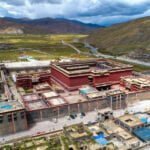Nestled on the northern banks of the Yarlung Tsangpo River in Bayi District’s Mirui Township. Demu holds a unique place in the hearts of those who seek spiritual depth and cultural richness. The name “De-mo,” meaning “Hen” in Tibetan, is derived from its location at the mouth of the Demula Mountain, making it a site of serene beauty and spiritual significance. Belonging to the Gelug sect of Tibetan Buddhism, this monastery stands as a testament to the enduring legacy of one of the “Four Great Regents” of Tibet during the Qing Dynasty, De-mo Hutuktu.
A Rich History Reborn
Founded in 1452 by the first Pabala Hutuktu, Dechen Dorje, De-mo Monastery was initially established on the north side of Demula Mountain (near today’s Lulang). After destruction by fire around 1655, the fourth Demo Hutuktu reincarnation rebuilt the monastery on the mountain’s south side, where it stands today. A major earthquake in 1950 devastated the monastery, but the tenth De-mo Hutuktu led its reconstruction, culminating in a grand completion ceremony in 1954. The rebuilt monastery featured a three-story Jampa Buddha Hall, housing three spectacular Buddha statues – Kashyapa Buddha, Sakyamuni Buddha, and Jampa Buddha – each around 10 meters tall, along with a Vajrayana hall adorned with various deities and a lineage of silver stupas of previous De-mo Hutuktus.
However, the Cultural Revolution brought destruction once again. In 1987, government funds facilitated the restoration of the grand hall, Buddha halls, teaching platforms, and monk quarters. Today, these halls house statues of Sakyamuni Buddha, Tsongkhapa, and various protective deities, with a Khenpo appointed by De-mo Lhacham overseeing the monastery for a three-year term.
Cultural Revival and Cham Dance
The De-mo Cham dance is a distinctive cultural tradition of Demo Monastery, embodying the spiritual and cultural essence of the community.
Despite the destruction during the Cultural Revolution, restorers gradually brought back the costumes, props, and instruments of De-mo Cham after the Eleventh Party Congress. Villagers from nearby areas flock to witness and participate in this vibrant dance, performed annually on the 28th and 29th days of the second Tibetan month, marking a solemn occasion.
The organizers divide the performance into two parts, showcasing a range of dances. These include the Black Hat Dancers, the Eight Manifestations of Padmasambhava, Protector Deities, and more. Performers accompany these dances with traditional instruments such as large drums, cymbals, long trumpets, and woodwinds. This lively event not only offers a glimpse into Tibetan religious life but also strengthens community bonds. Demo Monastery invites all to experience its tranquil beauty, rich history, and vibrant cultural expressions, making it a must-visit destination for those exploring the spiritual landscapes of Tibet.
Discover the Legacy of De-mo Hutuktu: A Spiritual Journey through Tibet
De-mo Hutuktu, also known as “Danjinlin Hutuktu,” holds a revered place in Tibetan Buddhism. The lineage began with the establishment of De-mo Monastery by the first Phakbala Living Buddha at the border of Bomi and Kongpo. His nephew, Kunchok Jena, took over as the monastery’s abbot, earning the title “De-mo Ba.” This marked the beginning of the De-mo Living Buddha lineage. Kunchok Jena’s reincarnation became De-mo Paljor Tashi, followed by De-mo Lhawang Trinley Namgyal (the third De-mo Living Buddha), who also served as the abbot of Gongbu Danjinlin Monastery, hence earning the title “Danjinlin Hutuktu.” Later, he was appointed as the overall abbot of Geluk monasteries in regions like Bomi, becoming known as the “De-mo Religious Leader.”
His reincarnation, De-mo Lhawang Tenpal Gyaltsen, met with Emperor Shunzhi of Qing Dynasty in 1652 alongside the fifth Dalai Lama. The fifth De-mo, Ngawang Lamu Jayang, participated in various Qing Dynasty religious celebrations.

Sixth Demo Living Buddha, Ngawang Jamphel Dele Gyatso
Ngawang Jampel Dele Gyatso, the sixth De-mo Living Buddha, took the role of Tibet’s first regent following the death of the seventh Dalai Lama in 1757 and served until 1777. The title “Hutuktu” was conferred upon him during his tenure. He also founded the Tengye Ling official residence in Lhasa, earning the name “Tengye Ling Hutuktu.” The Qing Emperor Renzong appointed Jigme Gyatso, the seventh De-mo Hutuktu, as the Tibetan regent from 1811 to 1818.
Trinley Rabgye, the ninth De-mo Hutuktu, held the position of Tibetan regent from 1886 to 1895, under the appointment of Emperor Guangxu. By serving as regent three times across different generations, the De-mo Hutuktus significantly influenced Tibet’s religious and political spheres for nearly 30 years. Their contributions were pivotal in fostering Tibet’s development, stability, and its relations with the central Qing Dynasty.
Visiting Tips for a Spiritual Retreat
- Getting There: De-mo Monastery is about 45 kilometres from Bayi Town. A chartered car can take you there for around 150 yuan.
- Cultural Gems Along the Way: On your journey, visit the cliff carvings and the “Ancient Mulberry Tree” at the foot of the northern mountains of Bonna Village. Legend has it that Princess Wencheng herself planted the ancient mulberry tree! The cliff carvings, featuring exquisite line engravings of Sakyamuni Buddha, the Four-armed Avalokiteshvara, and Pabam Zhupa, are a sight to behold.
Explore the spiritual legacy of De-mo Hutuktu and immerse yourself in the rich tapestry of Tibetan Buddhism. Visit De-mo Monastery and witness the cultural and spiritual treasures along the way for a journey that is as enlightening as it is unforgettable.
















